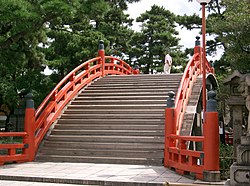Sumiyoshi Taisha
| Sumiyoshi taisha 住吉大社 |
|
|---|---|

The Taiko bashi at Sumiyoshi taisha
|
|
| Information | |
| Dedicated to | Sokotsutsu no Onomikoto Nakatsutsu no Onomikoto Uwatsutsu no Onomikoto Okinagatarashihime no Mikoto |
| Founded | 211 |
| Founder(s) | Tamomi no Sukune |
| Address | 2-9-89, Sumiyoshi, Sumiyoshi-ku, Osaka |
| Website | www |
|
|
|
Sumiyoshi taisha (住吉大社?), also known as Sumiyoshi Grand Shrine, is a Shinto shrine in Sumiyoshi ward in the city of Osaka, Japan. It is the main shrine of all the Sumiyoshi shrines in Japan. However, the oldest shrine that enshrines the Sumiyoshi sanjin, the three Sumiyoshi kami, is the Sumiyoshi shrine in Hakata.
It is called "Sumiyoshi-san" or "Sumiyossan" by the locals, and is famous for the large crowds that come to the shrine on New Year's Day for hatsumōde.
Sumiyoshi taisha enshrines the Sumiyoshi tanjin—Sokotsutsu no Onomikoto, Nakatsutsu no Onomikoto, and Uwatsutsu no Onomikoto—and Okinagatarashihime no Mikoto (Empress Jingū), and they are collectively known as the "Sumiyoshi Ōkami", the great gods of Sumiyoshi. Another term is "Sumiyoshi no Ōgami no Miya".
It gives its name to a style of shrine architecture known as Sumiyoshi-zukuri.
The shrine became the object of Imperial patronage during the early Heian period. In 965, Emperor Murakami ordered that Imperial messengers were sent to report important events to the guardian kami of Japan. These heihaku were initially presented to 16 shrines including Sumiyoshi.
Sumiyoshi was designated as the chief Shinto shrine (ichinomiya) for the former Settsu province.
From 1871 through 1946, Sumiyoshi taisha was officially designated one of the Kanpei-taisha (官幣大社?), meaning that it stood in the first rank of government supported shrines.
...
Wikipedia
